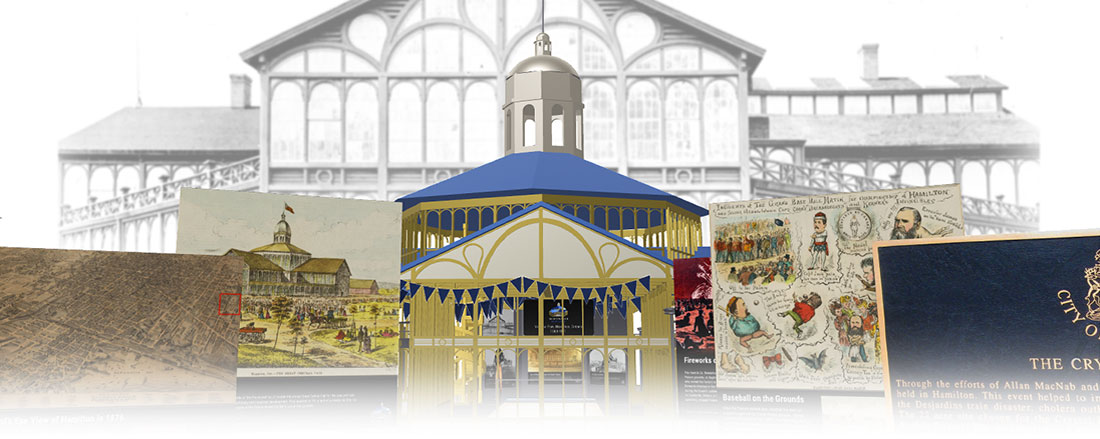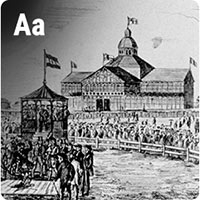THE CRYSTAL PALACE EXPERIENCE
VIEW ON YOUR MOBILE DEVICE
1. Scan QR code.
2. Open Experience with an iPhone or iPad.
Need to borrow a device? Contact HPL.
3. Place on a flat surface, and enjoy.
Step right up! More than a century later, Hamilton’s Crystal Palace rises again in Hamilton’s Victoria Park. An architectural marvel inside and out, this glass and wood structure housed military battalions, welcomed royalty, hosted elegant banquets and agricultural fairs for over 30 years. Scan the QR code on a smartphone or tablet to walk through its great halls, read about its architectural history, its rise to prominence and its demise. Discover an intriguing part of Hamilton history in all its “virtual” glory.
LEARN AND WATCH
Frequently Asked Questions, training videos, how-to notes and discussions with other AR fans. Check out our tips and tricks to create a 3D model or scan.
Hello and welcome to this audio tour of the Crystal Palace Experience presented by the City of Hamilton and the Hamilton Public Library. The Crystal Palace Experience is an Augmented Reality tour of the wood and glass structure that stood in Hamilton’s Victoria Park from 1860 to 1891.
Augmented Reality uses smartphones or tablets to overlay the real world with digital models that appear to be part of the scene, even as you move about while viewing it.
This audio tour will, we hope, make you feel as if you’re in the now-long-demolished Crystal Palace. Along the way you’ll learn about the Palace’s history, its construction and the events that took place there. So, let’s begin.
This grand tour starts as we approach the massive marble gates of the exhibition. An archway above us reads “The Crystal Palace Experience”. Hanging in mid-air below the arch is a quote from a 1900s historian who wrote:
“A generation from now, it is not at all unlikely, there will be few aware of the fact that Hamilton once possessed a building that occupied, in its time, quite a prominent position in the interests of the City, administering both to its profit and entertainment.”
We’re about to discover that very building. Just in front of us, under the archway, is a long blue carpet. At its end, far in the distance, is the remarkable Crystal Palace. It reaches over 100 feet in the air. Its light and airy walls are made of hundreds of panes of glass mounted into a wooden frame with a hexagonal centre and four identical wings pointing to the compass points: north, south, east and west. We’re approaching the east wing. If we were in Victoria Park today we’d be walking across the splash pad in the northwest corner of the Park and would be heading towards the swimming pool.
But between us and the Palace, on either side of the blue carpet, is a series of informative panels. We pass under the arch and walk along the cerulean carpet. A panel on the left announces that this digital project is a partnership of the City of Hamilton and the Hamilton Public Library.
Next, we come to birds-eye-view of Hamilton in 1876. It’s an engraved map that shows a grid of downtown Hamilton spreading far to the south. In an enlarged section we see an etching of the Crystal Palace in the northwest corner of what is today Victoria Park. Back then the Park, which was really the Crystal Palace grounds, was much larger.
Just beyond the map panel we see a misty grove of white pines and a sign acknowledging that we are on the traditional territories of the Erie, Neutral, Huron-Wendat, Haudenosaunee and Mississaugas.
We cross the carpet to the right side and discover a Victorian cartoon depicting baseball champions from the 1800s. Baseball was an important sport then, as it is today, on the Park grounds.
Next along the carpet’s edge we see a depiction of the Crystal Palace and its grounds on a fair day. There are hundreds of Hamiltonians in front of the Palace on a sunny morning. Some arrive by cart, others picnic on the grounds or stroll towards the Palace to sample local wares. All are dressed for a day at the fair.
Just beyond that panel, to the right of the carpet is a panel that depicts and evening fireworks display, a popular event during special occasions, including during the Queen’s Jubilee celebrations in 1887. The fireworks were supplied, for free, by the nearby Hand and Co. fireworks company, which is still in operation today.
And now, after that informative stroll, we’ve reached the front door of the Crystal Palace. It looms majestically above us. We pass through the entrance and step inside. It is a hall of wonders.
High glass walls stretch upward crisscrossed with thick timber joists. Blue pennants stretch to the corners of the central octagon, pinned to a beautiful white globe lantern high above us. We discover we are not alone. A young gentleman and lady in the finery of the 1800s glide by us.
We look down and at our feet we discover another carpet. This one stretches the full length of the Palace interior from east to west. This is the Carpet of History. On it is a chronological history of the Palace from its early days as the host of Ontario’s great provincial fair until, three decades later, when it was auctioned for a song, its glory days far behind it.
We look up and see a sign hovering in space that reads, “The Crystal Palace Experience Hamilton, Ontario 1860-1891.”
We look around and see there are exhibits in halls to the north and south of us and in a far gallery to the west.
We explore the south gallery first where we learn about the opulent events hosted at the Crystal Palace. They included sumptuous banquets for hundreds in the Palace’s huge octagonal dining area, the official opening by the Prince of Wales in 1860 and the Queen’s Jubilee celebration in 1887, at which Canada’s famous Jubilee Singers performed. Scenes in this gallery depict those feasts, highlights of the Prince’s visit to Hamilton and a promotional poster for the Jubilee Singers.
We stroll across the great hall to the north gallery. This exhibit celebrates the military history of the Crystal Palace. During its life, the Crystal Palace garrisoned local military troops including men from the 1st Battalion, the Prince Consort’s Own Rifle Brigade. We see an old photo of these men (and a couple of their children) posed in front of the Palace. These and other soldiers were garrisoned at the Palace in the 1860s to protect the area from the threats from the U.S. and Fenians. At other times troops trained on the grounds. An archeological dig by the City in 2019 found shards of pottery on the site believed to have come from bowls used by the soldiers. We see a photo of some of those colourful shards.
We now turn and make our way to the west gallery where we discover images of the Crystal Palace from its heyday to its decline. We see a glorious golden image of the Crystal Palace as its architect, Albert H. Mills, imagined. The real Palace is not quite as grand as Mills’ vision, but the photographs we see here show it proudly in its glory and sadly, in its decline in the late 1800s when it was allowed to stand ignominiously with broken windows and boarded doors. A final quote ends our visit to the exhibit:
“Thus did this locally celebrated structure -- so often the centre of the bucolic riches of the surrounding district, the skill of Hamilton artisans, the excitement of the ‘open-to-the-county and free-for-all hoss trot’ and the annual rallying-point of happy groups of young and old -- pass from view and become but a memory.”
We hope this exhibit has kept the memory of the remarkable Crystal Palace alive for another generation or two. Thanks for listening, and thanks for visiting the Crystal Palace Experience.
City of Hamilton Indigenous Land Acknowledgement
The City of Hamilton is situated upon the traditional territories of the Erie, Neutral, Huron-Wendat, Haudenosaunee and Mississaugas. This land is covered by the Dish With One Spoon Wampum Belt Covenant, which was an agreement between the Haudenosaunee and Anishinaabek to share and care for the resources around the Great Lakes. We further acknowledge that this land is covered by the Between the Lakes Purchase, 1792, between the Crown and the Mississaugas of the Credit First Nation. Today, the City of Hamilton is home to many Indigenous people from across Turtle Island (North America) and we recognize that we must do more to learn about the rich history of this land, so that we can better understand our roles as residents, neighbours, partners and caretakers.
City of Hamilton Plaque - The Crystal Palace
Through the efforts of Allan MacNab and Isaac Buchanan the 1860 Provincial Exposition was held in Hamilton. This event helped to improve the City's image which had suffered due to the Desjardins train disaster, cholera outbreaks and economic stagnation in the 1850s. The 22-acre site chosen for the Crystal Palace was bordered by King, Locke, Florence and Sophia streets. The architect was AH. Hills and the builder Robert Gordon. After the cornerstone laying on May 24, 1859, the Palace and grounds were later opened by Edward, The Prince of Wales, on September 20, 1860. Thereafter it became the site for the City's annual Great Central Fair.
The glass-enclosed Palace was surmounted by a flagpole dome and flanked by wings. Inside a floating stairway led from a banquet hall to an enlarged balcony. The Palace was used year-round for agricultural and industrial exhibits, drama, music and art. The grounds, which were enclosed by a board fence and wooden sidewalks, also included several livestock buildings. The largest fair attendance occurred in 1887 for the Queen's Jubilee. Four years later, the ageing buildings were auctioned and demolished. The vacant land was proposed for housing but instead was opened as Victoria Park in 1900. The elevated northern portion was later improved with walks and a playground. The lower part featured such athletics as baseball, football and ice skating. The Park welcomed home two local athletes: Billy Sherring in 1906, winner of the Marathon at the Olympic Games in Athens; and Bobby Kerr in 1908, winner of the 200-metre race at the Olympic Games in London.
An Architect Imagines His Dream Palace
In 1860, Albert H. Mills and a city engineer designed the Crystal Palace. In a lithograph in the exhibit by Mills you can see he had grander visions for the Palace than were realized. He imagined extended entranceways on the wings and the more detailed cornices on the octagonal mid-section. Also, in the litho are the actual dimensions of the Palace: 171 feet (52 meters) wide and long and 100 feet (30 meters) high. Mills explains: “the main building forms an octagon and is surmounted by a Greek cross with a dome over the intersection.”
A Bird’s Eye View of Hamilton in 1876
The exhibit shows a map of Hamilton in 1876 drawn by the American cartographer Herman Brosius. It includes an index to City of Hamilton buildings, churches, banks, schools, hotels and factories. In it you can see the Crystal Palace on its grounds. Note the grounds are much larger than the current Victoria Park and the Palace was in the northwest corner of the grounds where the splash pad and swimming pool are now, in Victoria Park.
A Prince of an Opening
On September 20, 1860, the Crystal Palace was officially opened by Albert Edward, Prince of Wales (who later became King Edward VII). He lunched with Sir Allan Napier MacNab at nearby Dundurn Castle afterwards. The Palace event was just one of the stops for the Prince who also opened the Hamilton Waterworks on the eastern edge of the City the previous day and was honoured with a parade through the City. A black and white version of this lithograph appeared in the Illustrated London News on November 17, 1860.
The Palace in Its Prime
The Crystal Palace and its grounds were a popular location for outdoor events such as concerts, fireworks displays, foot races, ring toss and, as shown in the etching, Highland dancing. The original grounds stretched from Locke to Dundurn streets and from King to Florence streets, except for a small section between Strathcona, Head and King streets. A reduced version of the grounds became what we now know as Victoria Park.
A Banquet in an Octagon
The Crystal Palace was originally built as an agricultural and industrial showcase. After its opening the building became host to a variety of events including banquets. The exhibit shows an etching of a feast that likely took place in the 1870s in the large central octagon of the Palace where the four wings come together.
Baseball on the Grounds
Outside the Palace, its grounds were host to a variety of events. Since the Palace’s earliest days, baseball has been an important sport on the Crystal Palace grounds. Games continued there into the late 1880s. An 1875 etching shown in the exhibit celebrates the events of a “grand base ball match” between Captain Cook’s Dreadnaughts and Kerner’s Invincibles.
Fireworks on Hand
The Hand & Co. fireworks factory was across the street from the Palace grounds, on Sophia Street (now Strathcona). William Hand, who moved his factory to Hamilton in 1875, often presented free fireworks displays in the Palace grounds. One of the largest was during the Queen’s Jubilee in 1887. Hand shifted his manufacturing to Cooksville, Ontario, in 1930. The company, which is still operating, stopped fireworks production in Canada in 2005.
The Jubilee Singers at the Palace
On June 22, 1887, as part of Hamilton’s Queen’s Jubliee celebrations, the Canadian Jubilee Singers performed at an outdoor concert on the Palace grounds. Most of the singers in the group were from the Hamilton area. The Singers, an all-Black group, were formed in 1878 and toured Great Britain and the United States.
The group is mentioned in Episode Seven, Season Ten of the popular CBC show Murdoch Mysteries, Murdoch in Ragtime.
Military on the Grounds
Troops were a familiar part of life on the Palace grounds in the 1860s. The 13th Battalion Volunteer Militia trained here. The battalion later became the Royal Hamilton Light Infantry (RHLI). The exhibit features a sketch by J. G. MacKay which shows The Hamilton Volunteer Field Battery on the grounds in 1876. One tent has “Canada Our Home” written on its side.
Threats from the South
The exhibit features a photo of a group of men in front of the Palace known as Captain Kingscote’s Company. Officially they were the 1st Battalion, the Prince Consort’s Own Rifle Brigade. These and other soldiers were garrisoned at the Palace in the 1860s to protect against the threat of militant members of the Fenian Brotherhood in the United States. They were also on guard in case America’s sense of “manifest destiny” triggered an assault as the U.S. aimed to take possession of the Americas.
Some members of the Fenian Brotherhood hoped their daring attacks would put pressure on Great Britain to withdraw from Ireland. Fenian raids did take place (Battle of Ridgeway, Battle of Fort Erie), in 1866.
U.S. manifest destiny was a cultural belief held by many Americans. They believed the eastern states had a duty to claim and tame the rest of North America. It never resulted in Canadian territory falling into U.S. hands.
Pottery at the Palace
In 2019-2020 the City of Hamilton commissioned an archeological excavation in Victoria Park near where the Crystal Palace once stood. Hundreds of artifacts were recovered, including some dating to the time the Palace existed (1860-1891). Some recovered pottery shards include fragments of undecorated pearlware, an early palette teacup, brown-printed refined white earthenware, two factory slip-banded bowls, a flow blue ironstone saucer and a black-printed ironstone teacup. Factory slip banding is a way of adding a band of colour to ceramic.
About a quarter of all the pottery found was decorated with broad, factory slip bands like the two pieces at the lower right. Archeologists think they might be fragments of soldiers’ bowls used for eating stew and porridge rations.
The Crystal Palace in Decline
By the late 1880s, the condition of the Crystal Palace was deteriorating dangerously. Woodwork was rotting and windows were damaged, vandalized or missing. The City was no longer interested in maintaining the structure. You can see the declining condition of the once magnificent building in this image. Note the broken and absent glazing. In Spring 1891, the building was sold at auction for $450. It was dismantled, with parts going to Claremont Park on the Mountain, the site of Auchmar, Isaac Buchanan’s estate.

 Download the Crystal Palace Experience
Download the Crystal Palace Experience







